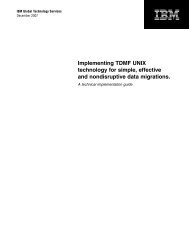A Primer for Healthcare Managers - IBM
A Primer for Healthcare Managers - IBM
A Primer for Healthcare Managers - IBM
Create successful ePaper yourself
Turn your PDF publications into a flip-book with our unique Google optimized e-Paper software.
6<br />
In<strong>for</strong>mation technology services involve the use<br />
and management of hardware, software, people,<br />
in<strong>for</strong>mation, maintenance, and support. The more<br />
comprehensive and integrated the services provided<br />
by a vendor, the less work on the side of the client in<br />
bringing different components together. For example,<br />
if the network service providers offer only the hardware<br />
installation and upgrade, the client organization<br />
needs to pick up the software and support. Crossfunctional<br />
integration of in<strong>for</strong>mation systems may<br />
further strain agencies’ resources. The outsourced<br />
IT service is more easily managed when<br />
it can function independently or interface easily with<br />
the rest of the in<strong>for</strong>mation systems. If this is<br />
not the case, the client organization, at the very<br />
least, needs to play the role of system integrator.<br />
As a result, the organizational resources required<br />
to carry out the integration can be overwhelming.<br />
The scale and complexity of the IT outsourcing<br />
arrangement also have bearing on the management<br />
ef<strong>for</strong>t. The larger and more complex an IT outsourcing<br />
arrangement gets, the more resources there are<br />
involved in coordinating, preparing <strong>for</strong> transition,<br />
and monitoring later on.<br />
Trends and Recent Developments<br />
<strong>Managers</strong> need to understand trends of IT outsourcing<br />
to manage outsourcing effectively. Both the IT<br />
outsourcing marketplace and the client organizations’<br />
utilization have seen significant changes over<br />
the past few years. The IT outsourcing market has<br />
gone through a shake-out period and become more<br />
mature. The most visible example is outsourcing<br />
application services. Initially, a large number of new<br />
and established companies entered the market <strong>for</strong><br />
application services in late 1999. After over two years<br />
of severe competition and market change, only<br />
a small number of vendors remain in the market.<br />
The successful vendors in the federal outsourcing<br />
marketplace are those well-established major<br />
contractors of government services who have established<br />
new IT service areas to meet the changing<br />
needs of their federal customers. After the shakeout<br />
period, the IT outsourcing market has become<br />
more mature. The vendors who provide value to<br />
customers and have a sound business model are<br />
able to survive and prosper.<br />
Two types of vendors have become the main <strong>for</strong>ces in<br />
the IT outsourcing market. The first type is the total<br />
solution provider, who offers an integrated solution<br />
<strong>for</strong> network or other services. It acts as a single<br />
service point <strong>for</strong> all IT service needs that an organization<br />
is willing to outsource. These total solution<br />
providers integrate various in<strong>for</strong>mation<br />
systems, providing hardware and software, and<br />
training and support. The second type of vendor<br />
includes those that are highly specialized in one type<br />
of service and have the capability of integrating with<br />
all remaining systems.<br />
To cope with the changing IT market and service<br />
needs, a growing trend among many organizations<br />
is the use of large integrated service providers or<br />
system integrators as their vendors. This use is<br />
prompted by the risk associated with merger and<br />
acquisition, or sometimes even bankruptcy, of<br />
small vendors. Another advantage of working with<br />
large system integrators is the flexibility in using<br />
most advanced technologies. System integrators are<br />
not bound to any technology, and they integrate<br />
various technologies as they help improve services.<br />
A complementary strategy is to build management<br />
capability to scan the market horizon and<br />
understand developments in technology and service<br />
needs as they arise.<br />
An understanding of the recent developments and<br />
trends makes managers aware of emerging issues.<br />
However, deciding on and managing an IT outsourcing<br />
project is a complicated undertaking.<br />
A thorough examination of value propositions and<br />
potential drawbacks is critical <strong>for</strong> determining the<br />
utility of outsourcing. There<strong>for</strong>e, the next section<br />
offers managers comprehensive lists of advantages<br />
and disadvantages of IT outsourcing to facilitate an<br />
in<strong>for</strong>med decision.<br />
Two Recent Developments of IT Outsourcing<br />
• Growing emphasis on security<br />
(in<strong>for</strong>mation assurance)<br />
• Move to a partnership model of outsourcing

















